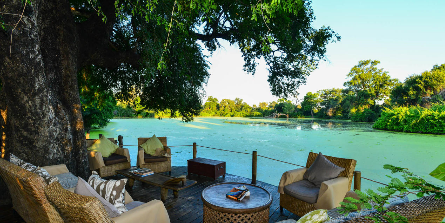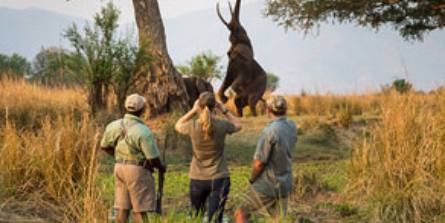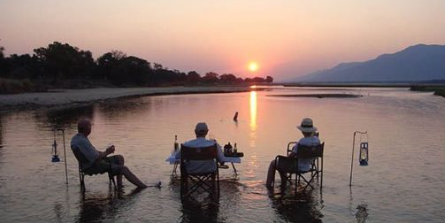Mana Pools is known for walking safaris and the abundance of wildlife that complements this activity. Kim Emmanuel looks at reasons why this part of Zimbabwe should be on every wildlife lover’s list.
Activity-rich, excellent guiding, and untouched wilderness are all descriptions associated with Mana Pools and the reasons this area is a ‘must-visit’. Mana Pools National Park borders the Zambezi River, downstream from Lake Kariba and was declared a Unesco World Heritage Site in 1984.
The word ‘Mana’ means four in the local Shona language, and refers to the four pools around the park’s headquarters that are home to hippopotamus, crocodiles, elephants and aquatic birds. “The frequency and diversity of animals is the real key to making the area such a sought-after destination by both newcomers and experienced safari travellers,” says Graham Simmonds, Wilderness Safaris Business Unit Manager in Zambezi.
The time to visit is during the dry season, from June till October, with the best time being September and October as large numbers of animals come to the river to drink and graze. While October can be very hot, it is worth enduring the heat to gain some of the best wildlife viewing available. During the rainy season (early November to the end of April) most camps close and animals move away from the river.
Where to stay

Kanga Camp’s main area
Kanga Camp is in the Kanga Pan of Mana Pools. The 12-bed tented camp has en-suite bathroom facilities with outdoor showers and basins overlooking the waterhole. Two of the tents can be used as family or honeymoon tents and have their own private dining and seating area. The camp’s main area has a comfortable lounge and dining area offering guests uninterrupted views of the active waterhole.
Zambezi Expeditions allows guests to experience all that Mana Pools has to offer on the banks of the Zambezi River. The 12-bed luxury mobile camp is set up prior to arrival. The six tents feature en-suite bathroom facilities that include flush toilets and an alfresco hot bucket shower. The camp has 12 volt lighting and charging facilities for cameras. A well serviced mess tent with a dining and seating area forms part of the camp.
Wilderness Safaris’ newly rebuilt Ruckomechi and the new Little Ruckomechi camps are also situated along the banks of the Zambezi in a private concession of the National Park. Ruckomechi comprises 10 en-suite tents, including two family rooms. The central dining, bar and lounge areas face the escarpment, and there is a separate pool and fire deck. A star-bed overlooking a waterhole completes the Ruckomechi experience. Little Ruckomechi comprises three twin-bedded tents able to accommodate six guests. There is also the option of booking the camp for sole use, where a fourth tent can be used and eight guests accommodated.
Many of the camps in Mana Pools also provide easy access to game-viewing activities, where often the action occurs close by. “Kanga Pan itself is the only known water source in the area available throughout the year, making it a hub for wildlife and a delight to explore on foot,” said Jemma Macmillan, African Bush Camps Marketing and PR.
What to do

Walking safaris with Wilderness Safaris in Mana Pools.
One of Mana Pools’ unique selling points and what makes the area a ‘must-visit’ is the safari experience that can be enjoyed on foot. Macmillan says the fact that Mana Pools is a flood plain with open spaces and good visibility, means that walking is a great option. “Walking allows for a very real and intimate experience with the wildlife, and gives one a true sense of freedom,” says Macmillan. Similarly, Sarah Stevens-Harrup, Director of Robin Pope Safaris Zimbabwe, also describes walking safaris as a unique experience. “It is a privilege to walk along the Zambezi shoreline, exploring the floodplain, which stretches along the river for 35km and delivers one breath-taking sight after the next.”
Experienced and well-trained guides, ensure the safety of guests on walking safaris. Guides remain constantly vigilant and aware of the risks and dangers involved in walks when they take guests out, says Macmillan, adding that a walking safari gives a guest some of the closest wildlife encounters they could ever wish for. Simmonds says the area boasts “some of Africa’s best guides” making it a “truly must-visit destination”.
Rich and diverse wildlife complete the Mana Pools walking safari experience. “All of Africa’s most sought-after game viewing can be seen here, except rhino, but lion, leopard, wild dog, hyena, buffalo, elephant, kudu, waterbuck, hippo, crocs and zebra are all plentiful … and the list goes on,” says Simmonds.
Although exploring the area on foot is what Mana Pools is known for, it’s not the only method of viewing wildlife. In addition to walking safaris, guests can also enjoy game drives, photographic safaris, boating and canoeing, as well as fishing. Open-sided vehicles, lots of time and hundreds of kilometres to explore this last true wilderness make for a leisurely pursuit in Mana, says Stevens-Harrup.
Not only are there great opportunities for wildlife sightings, but the changing landscape is also something to be enjoyed. “Game drives, either with a guide or as self-drive excursions, will take you through a great diversity of landscape, from the croton forests to the river banks,” says Stevens-Harrup.
Two new players enter Mana Pools

Mana Pools
In 2017, Mana Pools will welcome two new operators – Robin Pope Safaris and Great Plains Conservation, which will take on the Sapi Concession.
Robin Pope Safaris will set up a new semi-permanent camp, John’s Camp, in Mana Pools – named after renowned African safari guide, John Stevens. The 10 beds all have views across a flood plain towards the Zambezi River, and will open from April 14 until November 30.
Great Plains Conservation will set up a camp in the Sapi Concession, on the eastern boundary of Mana Pools, by the end of the year.
“As sustainable and conservation focused operators, the entry of Great Plains Conservation and Robin Pope Safaris can only mean a positive impact on the Zambezi Valley as a whole,” says Shelley Cox, Great Plains Ambassador Zimbabwe.























